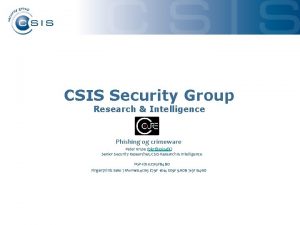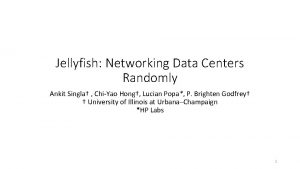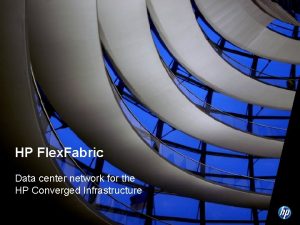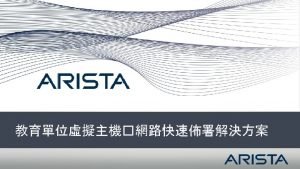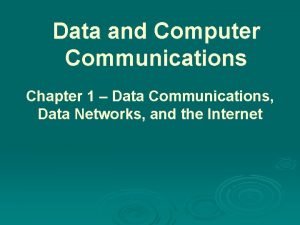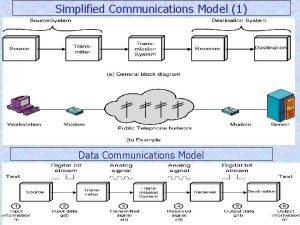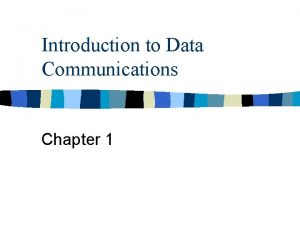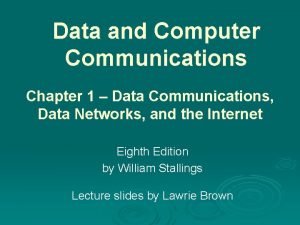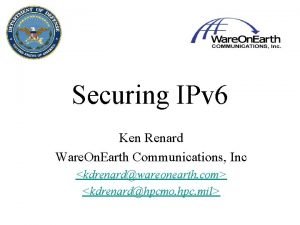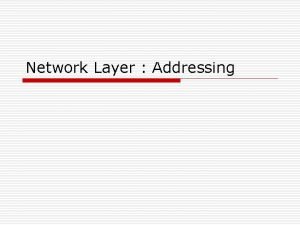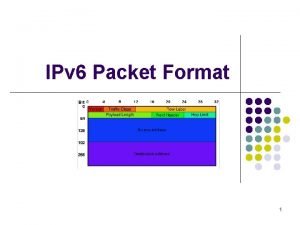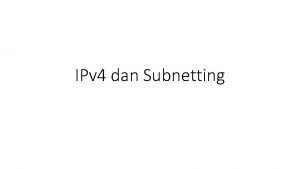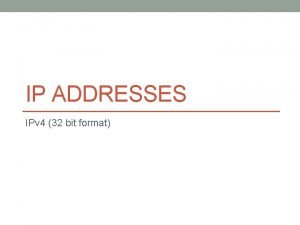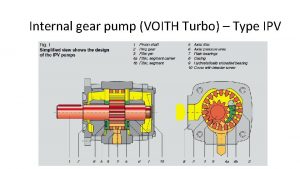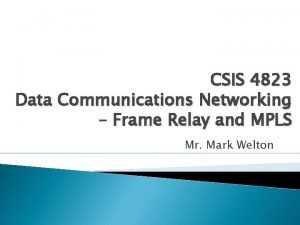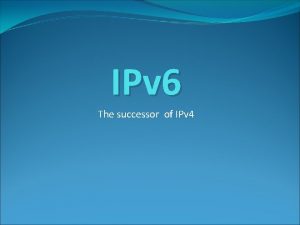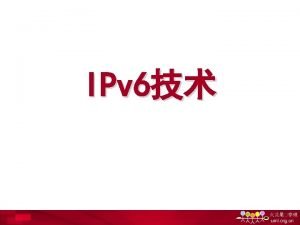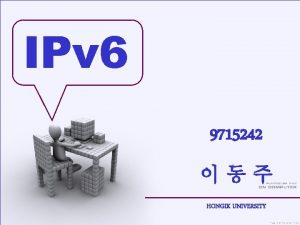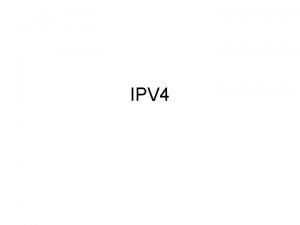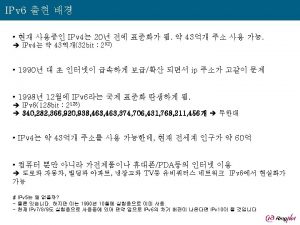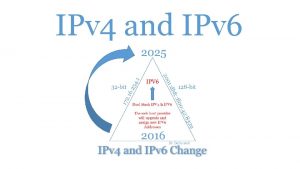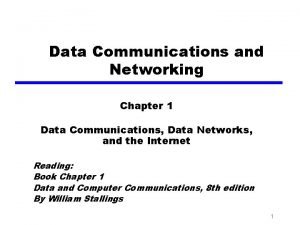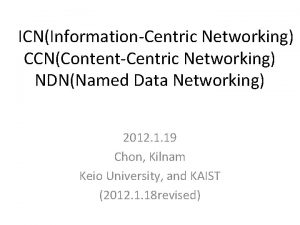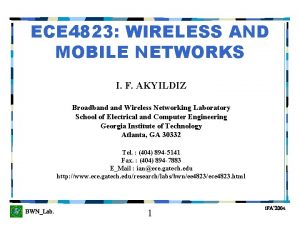CSIS 4823 Data Communications Networking IPv 6 Mr
























- Slides: 24

CSIS 4823 Data Communications Networking – IPv 6 Mr. Mark Welton

IPv 6 � Why IPv 6? � Ipv 4 is a 32 -bit addresses � This is 4, 294, 967, 296 (4. 2 x 109) IP addresses � Large blocks are considered wither reserved or unroutable (i. e. 10. 0/8 private address space) � There are currently 7 billion people on the Earth � We could not even have every person get a device with a public IP under IPv 4

IPv 6 � IPv 6 established in 1998 by RFC 2460 � Changes from IPv 4 � Security – extensions for authentication, data integrity, and confidentiality � Flow labels – classifying packets belonging to traffic flows � More options – more room for additional IP header options and extensions � Header format – reduced the required fields in the IP header � IP address space – 128 bits and “anycast” address, multicasts, and broadcast

IPv 6 addressing � IPv 6 uses 128 -bit addresses � This equates to 3. 40292367 x 1038 addresses � Roughly 295 IP addresses for every person on the Earth � Address scheme was designed to support efficient route aggregation � Subnets in IPv 6 are suppose to contain 264 addresses � This would mean that the IPv 4 space would consume 1/64 th of the address space available in just one IPv 6 subnet

IPv 6 addressing � Addresses do not use dotted decimal notation, but rather hexadecimal � IPv 6 address is commonly shown in four digit hexadecimal blocks � Each hexadecimal block is 16 -bits � AAAA: BBBB: CCCC: 0000: 11111: 1 111

IPv 6 addressing � IPv 6 shorthand allows for leading zeroes within a block can be eliminated � AAAA: BBBB: CCCC: 0000: 11111: 1 111 � So this address would become � AAAA: BBBB: CCCC: 0: 0: 11111: 1111

IPv 6 addressing � IPv 6 shorthand also allows any consecutive number of zeros to be replaced by double colon � so � AAAA: BBBB: CCCC: 0: 0: 11111: 1111 � would be shown as � AAAA: BBBB: CCCC: : 1111: 1111

IPv 6 addressing � the following three addresses are identical: � AA 76: 0000: 0012: A 322: FE 33: 2267 � AA 76: 0: 0: 0: 12: A 322: FE 33: 2267 � AA 76: : 12: A 322: FE 33: 2267

IPv 6 addressing � Why hexadecimal? � HEX: AA 76: 0000: 0012: A 322: FE 33: 2267 � If we represent this IPv 6 address in decimal it would have 12 more octets them a IPv 4 address � DEC: 170. 118. 0. 0. 18. 163. 34. 254. 51. 34. 103

IPv 6 addressing � IPv 6 is not backwards compatible to IPv 4 (you can not represent an IPv 6 address in IPv 4) � IPv 4 addresses are compatible with IPv 6 addresses ◦ This is done by setting the first 80 bits to 0 and the next 16 bits to 1, with the final bits being the IPv 4 address � the IPv 4 address of 10. 20. 30. 40 would be: � 0000: 0000: ffff: 10. 20. 30. 40 � 0: 0: 0: ffff: 10. 20. 30. 40 � : : ffff: 10. 20. 30. 40

IPv 6 Subnet Masks � Masking IPv 6 addresses is similar to IPv 4 in that we use prefix lengths � To understand it first you must know the rules for IPv 6 addressing

IPv 6 Subnet Masks � The first 48 bits of IPv 6 addresses are reserved for Internet routing (network address range) ◦ ffff: 0000: 0000 � The 16 bits from bit number 49 to bit number 54 are for defining subnets (subnetting range) ◦ 0000: ffff: 0000: 0000 � The last 64 bits are for device addresses ◦ 0000: ffff: ffff

IPv 6 Subnet Masks The most common subnet mask is and should be /64 � The American Registry for Internet Numbers has the following guidelines for assigning IPv 6 address space: � /64 – when it is known that only one subnet is needed � /56 – for small sites needing a few subnet within five years � /48 - for large sites � � � IETF (Internet Engineering Task Force) recommends all IPv 6 networks be /64 IPv 6 does not support NAT

IPv 6 Address Types � Like IPv 4, certain addresses are special and are identified by their high-order bits � These are defined in RFC 4291 Address type Binary prefix IPv 6 notation Section Unspecified 00. . . 0 (128 bits) : : /128 2. 5. 2 Loopback 00. . . 1 (128 bits) : : 1/128 2. 5. 3 Multicast 1111 FF 00: : /8 2. 7 Link-local unicast 1111111010 FE 80: : /10 2. 5. 6 Global unicast (everything else)

IPv 6 Address Types � Note the /128 this is the IPv 6 version of a /32 in IPv 4 � This specifies a host address (mask of all ones) � A /32 means a large aggregate Internet route in IPv 6 not a host address

IPv 6 Address Types � Unspecified � An address unspecified address is an address of all zeros � Packets with an unspecified destination will be dropped by routers � The source address may be unspecified by devices that have yet to learn their address

IPv 6 Address Types � Loopback � The address loopback address in IPv 6 is 0: 0: 1 or : : 1/128 � This is analogous to 127. 0. 0. 1 in IPv 4

IPv 6 Address Types � Multicast is a bit different in IPv 6, though the basic principle is the same � The first thing you should notice is that there is no concept of a broadcast in IPv 6 � If you want to send a packet to all nodes, you should use the link-local all nodes multicast address of ff 02: : 1

IPv 6 Address Types � Global unicast addresses are what you might call “normal” addresses, and will be assigned to interfaces on your devices

IPv 6 Address Types � Link-local unicast addresses are described in RFC 2373 (section 2. 5. 8) as follows: ◦ Link-Local addresses are designed to be used for addressing on a single link for purposes such as automatic address configuration, neighbor discovery, or when no routers are present. Routers must not forward any packets with Link-Local source or destination addresses to other links. � So what does that all mean?

IPv 6 Address Types � Link-local � It unicast is the IPv 6 equivalent of the 169. 254. x. x address space � In IPv 6 this will be in the fe 80: : /10 network � How do we create a unique address?

IPv 6 Address Types � Link-local � We unicast use the routing prefix combine with the MAC address � How many bits are in a MAC address? � How many bit are in the device part of the address?

IPv 6 Address Types � Link-local � We unicast pad the 48 bit MAC address with ff: fe in the middle to create the Extended Unique Identifier 64 (EUI-64) � We must also flip the seventh bit in the first octet of the MAC address � This bit is the locally administered bit used to indicate that the OS has altered the address

IPv 6 Address Types
 Backbone network components
Backbone network components Business data communications and networking
Business data communications and networking Introduction to data communications and networking
Introduction to data communications and networking Business data communications and networking
Business data communications and networking Sdn vs traditional networking
Sdn vs traditional networking Cu.moodle
Cu.moodle Csis secure dns
Csis secure dns Csis 110
Csis 110 Jellyfish networking data centers randomly
Jellyfish networking data centers randomly Data communication assignment questions
Data communication assignment questions Hp a5820
Hp a5820 Data center switch gartner
Data center switch gartner Telecommunication and data communication
Telecommunication and data communication Data and computer communications 10th edition
Data and computer communications 10th edition Data and computer communications
Data and computer communications Models of data communication
Models of data communication Introduction to data communications
Introduction to data communications Data and computer communications
Data and computer communications Simplified data communication model
Simplified data communication model Ken renard
Ken renard Ipv 4
Ipv 4 6 packet
6 packet Ipv 4 terdiri dari... *
Ipv 4 terdiri dari... * Ipv format
Ipv format Voith gear pump
Voith gear pump






